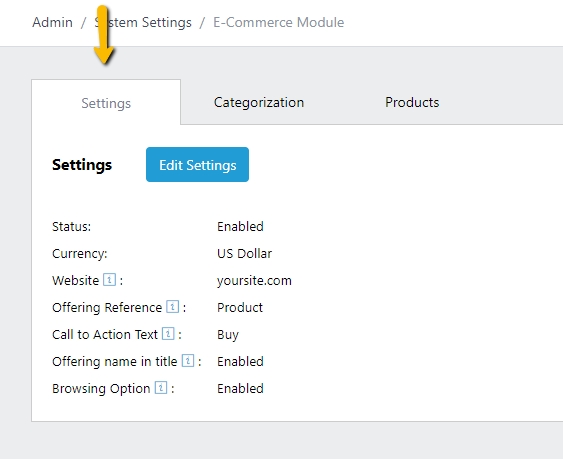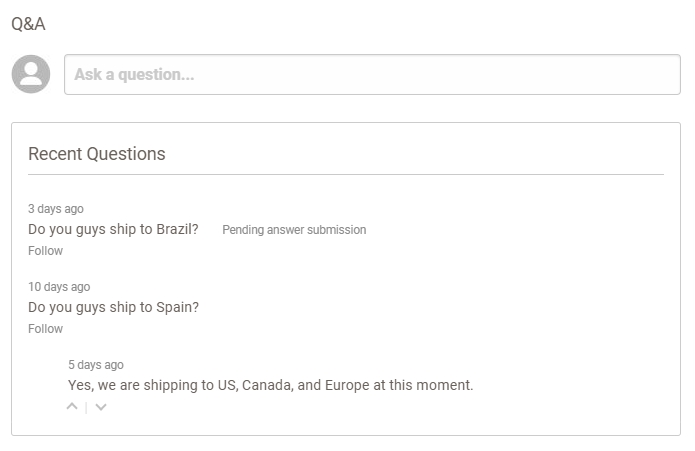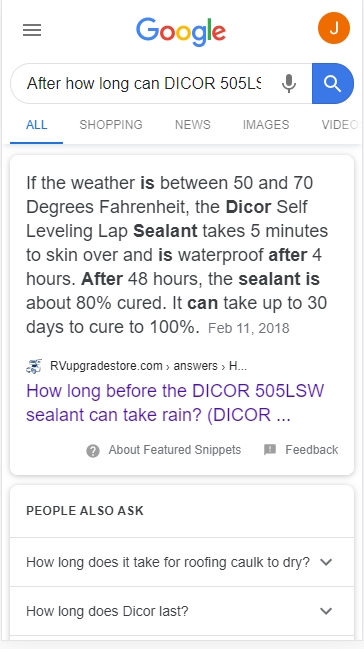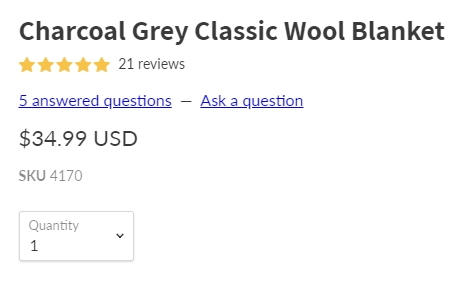Answerbase Ecommerce Product Q&A Full Integration Guide
Thanks for choosing Answerbase to power product questions and answers on your ecommerce store. This guide covers how to manage an in-depth integration and configuration of Answerbase to get the most out of product Q&A over the long run, which includes the full list of items we encourage you to manage for the best integration. This in-depth guide will be an investment of time to manage an ideal integration. We do cover how to manage a Phase I integration integration in our Getting Started with Answerbase for Ecommerce Guide, which will cover your needs to get Q&A successfully integrated and producing value for you, but if you'd like to do a deep dive into the most ideal integration this guide will be useful.
Before you follow the below instructions, make that you've signed up for an Answerbase account and access your Answerbase Administration Portal. Once in your administration portal, follow the below steps.
1) Configure Your Answerbase Ecommerce Settings
In your administration site, navigate to "System Settings > Ecommerce Module" to configure your foundational ecommerce settings before you install into your store. You'll see them displayed like this:

One of the most important settings to manage before you install is saving the "Website" value which is the domain of your store is, so we recognize that as a valid place to show your widget. Without this value identified, when you install your widget it won't recognize the URL that the widget is loading on and the widget won't recognize the product attribution to new questions appropriately. Make sure you fill out that setting along with any other preferential settings on that page. Now you're ready to install the Q&A widget on your product page.
2) Integrate Product Questions and Answers into Your Product Page
When integrating Answerbase Product Q&A into your ecommerce store, you have the option to manage the integration using either (1)Answerbase's widgets or (2) Answerbase's API. Here is an overview of why you may consider one or the other.
2.a) Answerbase Widgets
Our "Q&A Widget" is easily installed into your product page, so you can start engaging your customers with product questions and answers. You can customize the widget as you'd like, but here is an example of what a product page Q&A widget can look like:

If you've installed through an App store through one of the popular SaaS ecommerce platforms (Shopify, Bigcommerce, etc.) then this step may already be done for you. If you haven't, there are a couple quick steps to manage that.
You can find our widget under the main navigation under "Integration > Q&A Widget" within your Answerbase administration site. Grab that widget code and place it within your product page template where desired.
A couple notes on effectively integrating our widget:
Testing Your Ecommerce Q&A Integration into Your Product Pages
After you've tested and everything looks and works ok....you'll be notified when your customers ask you new questions.
We do recommend that you also integrate the scripts referenced in 2.c below along with the product Q&A widget integration.
2.b) Answerbase API Integration for Product Q&A
Customers who choose to move forward with an API integration, we look to make this as easy as possible for you. You can use the Answerbase Q&A widget to power the ask question field and form, and then utilize our API in order to pull the Q&A threads related to the product displayed and ensuring those threads are rendered as markup on your product page. The widget supports parameters (see parameters documentation) which allow you to identify that you want to hide the question list and only display the form, so users will be able to ask their questions on a call to action like this on your page.

That will ensure that your customers can easily ask questions, and we will be able to auto-suggest existing content when/if the question was already asked, etc. This saves you from needing to manage that side of the integration via API, and allows you to just pull a list of Q&A threads related to the product. Of course, if you want to build your own form and use our API to power the submission of questions, you can do that as well, but using the widget's capabilities will save you a lot of time.
To access your API, visit your Answerbase Administration Portal and go to "Integration > API" where you'll see access to the API and API documentation. You can see options within the documentation to pull questions lists, and you can pull them by product sku, as well as various other parameters and sorting options to accomplish your goals.
2.c) Scripts to Spawn Engagement and Track Conversions
We do have a couple other widgets which we encourage you to install as well, which will ensure you get the most engagement and can effectively track conversions that your Q&A activity assists with.
3) Import Any Existing Product Q&A Content (Optional)
Use our easy import process in order to seed your database with quality product Q&A content right from the start, which will save you time and increase engagement for your initial users. You may have content from a previous product Q&A software provider, or you may just have a collection of common questions that your customers have been asking through your contact form or other customer support channels. This content is valuable for both conversion and SEO, and you can easily import it into Answerbase so after you integrate your existing Q&A threads can show on your product pages.
Follow these steps to import your product Q&A content into Answerbase:
4) Customize Your Q&A Knowledge Base
Above and beyond powering Q&A on your product page, Answerbase builds a knowledge base of content with specific landing pages for select (or all, depending on your preferences), product Q&A threads, which enables you to get results like this as search engines index that content.

Those landing pages grow year over year search traffic to your site, and the average lifetime value of customers that come from those pages are up to 2x higher than normal organic search traffic.
The Q&A landing pages and the knowledge base that content it sits within is able to be styled by your team so that it can sit on your domain, adhere to your site's styles and designs. This section will go over the recommendations in order to effectively style that knowledge base so that it reflects consistent with your site and brand.
4.a) Reflecting the Knowledge Base and Landing Pages on Your Domain
We have two options for ensuring that your growing knowledge base and landing pages reflect on your domain, which is having it on a subdirectory of your site (example: yourdomain.com/answers) or a subdomain of your site (example: answers.yourdomain.com). When you first signup for Answerbase your knowledge base is sitting on an Answerbase subdomain (example: yoursite.answerbase.com), but in your Answerbase Administration Portal under "Customization > Domain Name" you have the ability to configure it to sit on your own domain. Here are some details around the options to ensure the knowledge base is on your domain.
4.b) Visual Styling of Your Knowledge Base and Landing Pages
Answerbase provides a simple template by default, and then you can style that template by using the tools that you find under "Customization" in your Answerbase Administration Portal. Some ecommerce merchants choose to just add their logo and adjust color settings on their knowledge base, others will dive in and ensure that they reflect their site's header, footer, CSS, favicon, and other attributes of the design to ensure it's 100% consistent. Answerbase provides the tools to accomplish all of that as you can overwrite our default CSS, edit your content areas which includes the header, footer, advertising placements, etc.
5) Add Your Sitemap to Google and other Search Engines
Answerbase builds and maintains a sitemap for all of the content generated and displayed within your knowledge base, ensuring search engines can index all of that content and ensure your content is being distributed in their search results. In your Answerbase Administration Portal, you can go under "System Settings > SEO > Sitemap & Verification (tab)" to find the location of your sitemap and the ability to verify. This allows you to add that sitemap to Google Search Console and other services for indexing. The sitemap is updated consistently as more content is added to your knowledge base and consistent with the SEO settings you manage within your Answerbase Administration Portal.
6) Review Our Ecommerce Q&A Administration Overview
Once you're product Q&A widget is imported, Answerbase will notify you when a new question is asked about your products. From that notification, you'll be lead to Answerbase's administration site where you can see the new question and respond to it. If you'd like an overview of our administration tools, please review our Administration Overview for Ecommerce Product Q&A.
Once you've accomplished the above, you've set the foundation for customer engagement and search traffic growth. We recommend that you see how engagement goes over your trial period and Contact Us if you're needing any other assistance.
Before you follow the below instructions, make that you've signed up for an Answerbase account and access your Answerbase Administration Portal. Once in your administration portal, follow the below steps.
1) Configure Your Answerbase Ecommerce Settings
In your administration site, navigate to "System Settings > Ecommerce Module" to configure your foundational ecommerce settings before you install into your store. You'll see them displayed like this:

One of the most important settings to manage before you install is saving the "Website" value which is the domain of your store is, so we recognize that as a valid place to show your widget. Without this value identified, when you install your widget it won't recognize the URL that the widget is loading on and the widget won't recognize the product attribution to new questions appropriately. Make sure you fill out that setting along with any other preferential settings on that page. Now you're ready to install the Q&A widget on your product page.
2) Integrate Product Questions and Answers into Your Product Page
When integrating Answerbase Product Q&A into your ecommerce store, you have the option to manage the integration using either (1)Answerbase's widgets or (2) Answerbase's API. Here is an overview of why you may consider one or the other.
- Answerbase Widgets: This integration is the most common form of integration for ecommerce stores, and is a simple JavaScript snippet that you place within your product page which powers your product questions and answers. The benefits of this is it's all done for you, you just place the snippet and go. Google will in fact recognize what the JavaScript renders on the page and you can get ranked for those new key phrases in search results for SEO, but other search engines may not have as advanced capabilities.
- Answerbase API: This integration will allow you to grab the content and display the markup of the Q&A threads within your product page, which is the most optimized way of managing an integration for SEO. This ensures that all crawlers that crawl the markup of your page can also see each question and answer thread within that page.
2.a) Answerbase Widgets
Our "Q&A Widget" is easily installed into your product page, so you can start engaging your customers with product questions and answers. You can customize the widget as you'd like, but here is an example of what a product page Q&A widget can look like:

If you've installed through an App store through one of the popular SaaS ecommerce platforms (Shopify, Bigcommerce, etc.) then this step may already be done for you. If you haven't, there are a couple quick steps to manage that.
You can find our widget under the main navigation under "Integration > Q&A Widget" within your Answerbase administration site. Grab that widget code and place it within your product page template where desired.
A couple notes on effectively integrating our widget:
- Ecommerce Parameters: Ensure that when you place the widget code within your site, you need to ensure that when your product page renders, the product parameters within the widget script needs to be populated with the appropriate product information including product id (sku), product title, product description, product URL, and product image URL. This let's the widget know what product the page is related to and then we attribute any new questions asked from that page to the appropriate product, as well as ensure that the appropriate Q&A threads are showing on that page. See our Ecommerce Widget Installation Instructions for details on parameters that we'll need you to pass into the widget code for an effective ecommerce integration.
- Auto-Suggesting Answers from Product Information: You can configure Answerbase's widget so that if a customer asks a question about information you've already provided in your product description and specifications, Answerbase can auto-suggest that information to the user so they get their answer immediately and you don't have to answer questions about information you've already provided. Please read this article on how to auto-suggest answers from product details and specifications for details on how to configure that.
- Other Widget Parameters: As long as you're populating the product parameters into the widget, that is all you'll need for the ecommerce integration. If you'd like to see what other items you can control on the widget, see our Widget Installation Guide for a full list of parameters that our widget supports, which will allow you to configure your widget so it looks and acts as you'd like.
Testing Your Ecommerce Q&A Integration into Your Product Pages
After you've tested and everything looks and works ok....you'll be notified when your customers ask you new questions.
We do recommend that you also integrate the scripts referenced in 2.c below along with the product Q&A widget integration.
2.b) Answerbase API Integration for Product Q&A
Customers who choose to move forward with an API integration, we look to make this as easy as possible for you. You can use the Answerbase Q&A widget to power the ask question field and form, and then utilize our API in order to pull the Q&A threads related to the product displayed and ensuring those threads are rendered as markup on your product page. The widget supports parameters (see parameters documentation) which allow you to identify that you want to hide the question list and only display the form, so users will be able to ask their questions on a call to action like this on your page.

That will ensure that your customers can easily ask questions, and we will be able to auto-suggest existing content when/if the question was already asked, etc. This saves you from needing to manage that side of the integration via API, and allows you to just pull a list of Q&A threads related to the product. Of course, if you want to build your own form and use our API to power the submission of questions, you can do that as well, but using the widget's capabilities will save you a lot of time.
To access your API, visit your Answerbase Administration Portal and go to "Integration > API" where you'll see access to the API and API documentation. You can see options within the documentation to pull questions lists, and you can pull them by product sku, as well as various other parameters and sorting options to accomplish your goals.
2.c) Scripts to Spawn Engagement and Track Conversions
We do have a couple other widgets which we encourage you to install as well, which will ensure you get the most engagement and can effectively track conversions that your Q&A activity assists with.
- Product Page Call to Action Widget: This widget is typically placed next to the review summary underneath the title of a product page, where customers can see how many Q&A threads are available for that product and gives them the ability to pose their own question. You can see our Guide to Install the Call to Action Widget for instructions on how to install. The widget is typically placed just below the product title, alongside a summary of the reviews for the product. You can see an example of how this widget looks here where you see that there are 5 questions answered about the product and the ability to ask their own question.

- Conversion Tracking: In your administration site, if you go under "System Settings > Ecommerce Module > Tracking Code", you can place tracking code on your order confirmation page which allows Answerbase to track how many sales your Q&A content is assisting in as well as the value of those orders. You can see our Guide to Install Ecommerce Tracking Code Here. This helps ensure you're getting a healthy ROI and can assist with optimizing your content and activity to get you the best results.
3) Import Any Existing Product Q&A Content (Optional)
Use our easy import process in order to seed your database with quality product Q&A content right from the start, which will save you time and increase engagement for your initial users. You may have content from a previous product Q&A software provider, or you may just have a collection of common questions that your customers have been asking through your contact form or other customer support channels. This content is valuable for both conversion and SEO, and you can easily import it into Answerbase so after you integrate your existing Q&A threads can show on your product pages.
Follow these steps to import your product Q&A content into Answerbase:
- Importing Any Users (if necessary): If you don't have any specific user attribution to your product Q&A, you can skip this step and only import the Q&A content. If your Q&A content is tied to existing users, then you'll want to import the users that are associated with your Q&A content first so we know who to associate the questions and answers to. In your administration site, see under "Users > Import Users" where you can see our CSV import template and formatting guide, and import the users who were responsible for posting the Q&A content. This will allow us to associate the Q&A content to the appropriate users when you import the content.
- Importing Product Q&A Content: Under "Content" you'll see the option to "Import Content". Here you can see our CSV template and formatting guide for the content, which allows you to import your existing product Q&A content and ensure that valuable content is available for future customers browsing your products.
4) Customize Your Q&A Knowledge Base
Above and beyond powering Q&A on your product page, Answerbase builds a knowledge base of content with specific landing pages for select (or all, depending on your preferences), product Q&A threads, which enables you to get results like this as search engines index that content.

Those landing pages grow year over year search traffic to your site, and the average lifetime value of customers that come from those pages are up to 2x higher than normal organic search traffic.
The Q&A landing pages and the knowledge base that content it sits within is able to be styled by your team so that it can sit on your domain, adhere to your site's styles and designs. This section will go over the recommendations in order to effectively style that knowledge base so that it reflects consistent with your site and brand.
4.a) Reflecting the Knowledge Base and Landing Pages on Your Domain
We have two options for ensuring that your growing knowledge base and landing pages reflect on your domain, which is having it on a subdirectory of your site (example: yourdomain.com/answers) or a subdomain of your site (example: answers.yourdomain.com). When you first signup for Answerbase your knowledge base is sitting on an Answerbase subdomain (example: yoursite.answerbase.com), but in your Answerbase Administration Portal under "Customization > Domain Name" you have the ability to configure it to sit on your own domain. Here are some details around the options to ensure the knowledge base is on your domain.
- Subdirectory of Your Domain (yoursite.com/answers): You can find this option under your advanced domain name settings, when visiting "Customization > Domain Name" in your Answerbase administration portal. We manage this through a reverse proxy, which you setup on your servers to recognize that any traffic going to the subdirectory you'd like your knowledge base to sit on...will reverse proxy to show the Q&A content powered by Answerbase. This ensures that all your Q&A content is shown on your desired subdirectory and both search engines and end users recognize that as where the content lives. (See an article by MOZ on reverse proxies and how they can help your SEO)
- Subdomain of Your Domain (answers.yoursite.com): You can find this option under your simple settings when visiting "Customization > Domain Name" in your Answerbase administration portal. This is managed by a simple cname reference, where you create your subdomain through whoever you manage your domain through (Godaddy or other) and then simply create a CNAME record that points to cname.answerbase.com. This can be done in less than 10 minutes.
4.b) Visual Styling of Your Knowledge Base and Landing Pages
Answerbase provides a simple template by default, and then you can style that template by using the tools that you find under "Customization" in your Answerbase Administration Portal. Some ecommerce merchants choose to just add their logo and adjust color settings on their knowledge base, others will dive in and ensure that they reflect their site's header, footer, CSS, favicon, and other attributes of the design to ensure it's 100% consistent. Answerbase provides the tools to accomplish all of that as you can overwrite our default CSS, edit your content areas which includes the header, footer, advertising placements, etc.
5) Add Your Sitemap to Google and other Search Engines
Answerbase builds and maintains a sitemap for all of the content generated and displayed within your knowledge base, ensuring search engines can index all of that content and ensure your content is being distributed in their search results. In your Answerbase Administration Portal, you can go under "System Settings > SEO > Sitemap & Verification (tab)" to find the location of your sitemap and the ability to verify. This allows you to add that sitemap to Google Search Console and other services for indexing. The sitemap is updated consistently as more content is added to your knowledge base and consistent with the SEO settings you manage within your Answerbase Administration Portal.
6) Review Our Ecommerce Q&A Administration Overview
Once you're product Q&A widget is imported, Answerbase will notify you when a new question is asked about your products. From that notification, you'll be lead to Answerbase's administration site where you can see the new question and respond to it. If you'd like an overview of our administration tools, please review our Administration Overview for Ecommerce Product Q&A.
Once you've accomplished the above, you've set the foundation for customer engagement and search traffic growth. We recommend that you see how engagement goes over your trial period and Contact Us if you're needing any other assistance.

